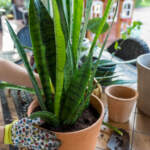

Snake plants, scientifically known as Sansevieria, are a highly popular and resilient genus of plants that have carved a niche in the world of indoor gardening. Hailing from the arid deserts of Africa, Madagascar, and southern Asia, these plants are lauded for their striking architectural beauty and exceptional adaptability, making them a favored choice for both seasoned gardeners and novices alike.
Characterized by their sword-like, upright leaves, snake plants present a range of patterns and colors, from deep greens to light, variegated hues of yellow and green. Their leaves, which can grow quite tall, display a captivating mix of horizontal stripes and mottled patterns, giving them a unique visual appeal. This foliage not only adds a touch of sophistication to any space but also plays a vital role in air purification, making these plants a healthy addition to any indoor environment.
One of the key reasons behind the popularity of snake plants is their remarkable tolerance to a wide range of growing conditions. They can thrive in both low light and bright, indirect sunlight, and are known for their ability to withstand neglect. This hardiness stems from their succulent nature, allowing them to efficiently store water and endure longer periods without watering. It’s a common saying that the only way to kill a snake plant is to over-water it, highlighting their exceptional resilience.
In addition to their aesthetic and practical benefits, snake plants hold cultural significance in many societies, often associated with qualities like longevity and tenacity. They are also a symbol of good luck in some cultures, making them a meaningful gift.
Whether used as a standalone feature or as part of a diverse plant collection, snake plants bring a sense of calm, elegance, and a touch of the exotic to any indoor space. Their low maintenance requirements, coupled with their air-purifying abilities, make them an ideal choice for modern living spaces, offices, and even less attentive plant owners.
This comprehensive guide will explore the essential aspects of caring for Sansevieria, covering everything from light requirements to common problems and their solutions.
Light Requirements
One of the reasons for the popularity of Sansevieria is its adaptability to various lighting conditions. These plants prefer bright, indirect light but can tolerate lower light levels, making them ideal for spots in your home that other plants might not thrive in. However, it’s important to avoid direct sunlight, which can scorch their leaves, causing them to lose their vibrant coloration.
Watering
Overwatering is the most common issue faced by Sansevieria owners. These plants are drought-tolerant and require minimal watering. Allow the soil to dry completely between waterings. In the winter, reduce the frequency even more, as the plant goes into a dormant state. Use well-draining soil and pots with drainage holes to prevent water from accumulating at the roots, which can lead to root rot.
Temperature and Humidity
Sansevieria plants prefer warm conditions and do well in typical indoor temperatures ranging from 60-80°F (15-27°C). They are not frost-tolerant, so it’s important to keep them away from drafty windows in the winter. While they can adapt to low humidity levels, they thrive in a more humid environment. If your home is particularly dry, consider using a humidifier or placing a water tray near the plant.
Soil and Fertilizer
The right soil mix is crucial for the health of your Sansevieria. Use a well-draining potting mix, ideally one designed for cacti or succulents. These plants are light feeders, so a balanced, water-soluble fertilizer applied sparingly during the growing season (spring and summer) is sufficient. Avoid over-fertilizing, as this can harm the plant.
Potting and Repotting
Sansevieria plants are slow growers and do not require frequent repotting. It’s generally recommended to repot every 2-3 years or when the plant becomes root-bound. When repotting, choose a pot only slightly larger than the current one, as too much space can lead to excess soil moisture.
Propagation
Propagating Sansevieria is simple and can be done through leaf cuttings or division. To propagate by leaf cuttings, cut a healthy leaf near the base and allow the cut end to callous over for a day or two. Then, plant the cutting in well-draining soil. For division, carefully remove the plant from its pot and separate the pups from the mother plant, repotting them into their own containers.
Common Problems
Sansevieria plants are generally pest-resistant, but they can occasionally be affected by mealybugs and spider mites. Regularly inspect your plant and treat infestations promptly with insecticidal soap or neem oil. Overwatering and poor drainage are the primary causes of root rot, a serious condition that can be fatal to the plant. If you suspect root rot, remove the plant from its pot, trim away any rotten roots, and repot in fresh, dry soil.
Varieties of Sansevieria
There are many varieties of Sansevieria, each with its unique characteristics. Some popular types include Sansevieria trifasciata ‘Laurentii’, known for its yellow-edged leaves, and Sansevieria cylindrica, with its round, spear-like foliage. Exploring different varieties can add diversity to your collection.
Click here to learn more about all the different varieties of Snake Plants
Air-Purifying Qualities
One of the most remarkable qualities of Sansevieria is its ability to purify the air. According to NASA’s Clean Air Study, Sansevieria can remove toxins such as formaldehyde and benzene from the air, contributing to a healthier living environment.
Design and Styling
Sansevieria plants are versatile in terms of interior design. Their upright growth pattern and variety of sizes make them suitable for both floor and tabletop displays. They pair well with both modern and traditional decor and can be used to create a focal point in a room or to add a touch of greenery to a quiet corner.
Final Thoughts
Caring for Sansevieria plants is rewarding and straightforward, making them an excellent choice for both novice and experienced plant enthusiasts. With their striking appearance, air-purifying abilities, and minimal care requirements, they are an ideal addition to any indoor space.





